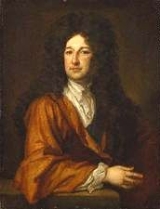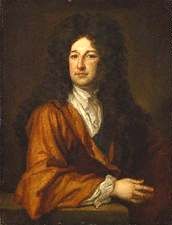
Charles Seymour, 6th Duke of Somerset
Encyclopedia

Charles Seymour, 2nd Baron Seymour of Trowbridge
Charles Seymour, 2nd Baron Seymour of Trowbridge was the son of Francis Seymour, 1st Baron Seymour of Trowbridge, whom he succeeded in the barony in 1664....
, and Elizabeth Alington (1635–1692), he succeeded his brother Francis Seymour, 5th Duke of Somerset
Francis Seymour, 5th Duke of Somerset
Francis Seymour, 5th Duke of Somerset , known as 3rd Baron Seymour of Trowbridge between 1665 and 1675, was an English peer....
, to the dukedom when the latter was shot in 1678. He also inherited the title of Baron Seymour of Trowbridge.
Charles was educated at Trinity College, Cambridge
Trinity College, Cambridge
Trinity College is a constituent college of the University of Cambridge. Trinity has more members than any other college in Cambridge or Oxford, with around 700 undergraduates, 430 graduates, and over 170 Fellows...
. In 1682 he married a great heiress, Elizabeth Percy
Elizabeth Seymour, Duchess of Somerset
Elizabeth Percy, Duchess of Somerset , major heiress, was born Lady Elizabeth Percy, the only surviving child of the 11th Earl of Northumberland and deemed Baroness Percy in her own right. She carried the earldom of Northumberland to her son Algernon...
, daughter of Joceline Percy, 11th Earl of Northumberland
Joceline Percy, 11th Earl of Northumberland
Josceline Percy, 11th Earl of Northumberland, 5th Baron Percy was an English peer.Percy was the eldest son of Algernon Percy, 10th Earl of Northumberland and his second wife, Elizabeth Howard, daughter of Theophilus Howard, 2nd Earl of Suffolk...
, who brought him immense estates, including Alnwick Castle
Alnwick Castle
Alnwick Castle is a castle and stately home in the town of the same name in the English county of Northumberland. It is the residence of the Duke of Northumberland, built following the Norman conquest, and renovated and remodelled a number of times. It is a Grade I listed building.-History:Alnwick...
, Petworth House
Petworth House
Petworth House in Petworth, West Sussex, England, is a late 17th-century mansion, rebuilt in 1688 by Charles Seymour, 6th Duke of Somerset, and altered in the 1870s by Anthony Salvin...
, Syon House
Syon House
Syon House, with its 200-acre park, is situated in west London, England. It belongs to the Duke of Northumberland and is now his family's London residence...
and Northumberland House
Northumberland House
Northumberland House was a large Jacobean mansion in London, which was so called because for most of its history it was the London residence of the Percy family, who were the Earls and later Dukes of Northumberland, and one of England's richest and most prominent aristocratic dynasties for many...
in London
London
London is the capital city of :England and the :United Kingdom, the largest metropolitan area in the United Kingdom, and the largest urban zone in the European Union by most measures. Located on the River Thames, London has been a major settlement for two millennia, its history going back to its...
.
In 1683, Somerset received an appointment in the king’s household, and two years later a colonelcy of dragoons; but at the Glorious Revolution
Glorious Revolution
The Glorious Revolution, also called the Revolution of 1688, is the overthrow of King James II of England by a union of English Parliamentarians with the Dutch stadtholder William III of Orange-Nassau...
he bore arms for the Prince of Orange
William III of England
William III & II was a sovereign Prince of Orange of the House of Orange-Nassau by birth. From 1672 he governed as Stadtholder William III of Orange over Holland, Zeeland, Utrecht, Guelders, and Overijssel of the Dutch Republic. From 1689 he reigned as William III over England and Ireland...
. Having befriended Princess Anne
Anne of Great Britain
Anne ascended the thrones of England, Scotland and Ireland on 8 March 1702. On 1 May 1707, under the Act of Union, two of her realms, England and Scotland, were united as a single sovereign state, the Kingdom of Great Britain.Anne's Catholic father, James II and VII, was deposed during the...
in 1692, he became a favourite of hers after her accession to the throne, receiving the post of Master of the Horse
Master of the Horse
The Master of the Horse was a position of varying importance in several European nations.-Magister Equitum :...
in 1702. Finding himself neglected by Marlborough
John Churchill, 1st Duke of Marlborough
John Churchill, 1st Duke of Marlborough, Prince of Mindelheim, KG, PC , was an English soldier and statesman whose career spanned the reigns of five monarchs through the late 17th and early 18th centuries...
, he made friends with the Tories
Tory
Toryism is a traditionalist and conservative political philosophy which grew out of the Cavalier faction in the Wars of the Three Kingdoms. It is a prominent ideology in the politics of the United Kingdom, but also features in parts of The Commonwealth, particularly in Canada...
, and succeeded in retaining the queen’s confidence, while his wife replaced the Duchess of Marlborough as Mistress of the Robes
Mistress of the Robes
The Mistress of the Robes is the senior lady of the British Royal Household. Formerly responsible for the Queen's clothes and jewellery, the post now has the responsibility for arranging the rota of attendance of the Ladies in Waiting on the Queen, along with various duties at State ceremonies...
in 1711. The Duchess became the Queen's closest confidante, causing Jonathan Swift
Jonathan Swift
Jonathan Swift was an Irish satirist, essayist, political pamphleteer , poet and cleric who became Dean of St...
to direct at her a violent satire The Windsor Prophecy, in which he accused her of murdering her previous husband, Thomas Thynne
Thomas Thynne (landowner)
Thomas Thynne was an English landowner of the family that is now headed by the Marquess of Bath and politician who sat in the House of Commons from 1670 to 1682. He went by the nickname "Tom of Ten Thousand" due to his great wealth...
. The Duchess retained her influence even after the Queen following a quarrel, dismissed the Duke as Master of the Horse in 1712.
In the memorable crisis when Anne was at the point of death, Somerset acted with Argyll
John Campbell, 2nd Duke of Argyll
Field Marshal John Campbell, 2nd Duke of Argyll, 1st Duke of Greenwich KG , known as Iain Ruaidh nan Cath or Red John of the Battles, was a Scottish soldier and nobleman.-Early Life:...
, Shrewsbury
Charles Talbot, 1st Duke of Shrewsbury
Charles Talbot, 1st Duke of Shrewsbury, KG, PC was an English statesman. Born to Roman Catholic parents, he remained in that faith until 1679 when—during the time of the Popish Plot and following the advice of the divine John Tillotson—he converted to the Church of England...
and other Whig
British Whig Party
The Whigs were a party in the Parliament of England, Parliament of Great Britain, and Parliament of the United Kingdom, who contested power with the rival Tories from the 1680s to the 1850s. The Whigs' origin lay in constitutional monarchism and opposition to absolute rule...
nobles who, by insisting on their right to be present in the Privy Council
Privy Council of the United Kingdom
Her Majesty's Most Honourable Privy Council, usually known simply as the Privy Council, is a formal body of advisers to the Sovereign in the United Kingdom...
, secured the Hanoverian
Hanoverian
The adjective Hanoverian is used to describe:* British monarchs or supporters of the House of Hanover, the dynasty which ruled the United Kingdom from 1714 to 1901.* things relating to the Electorate of Hanover, Kingdom of Hanover, or Province of Hanover...
succession to the Crown.
He retained the office of Master of the Horse under George I
George I of Great Britain
George I was King of Great Britain and Ireland from 1 August 1714 until his death, and ruler of the Duchy and Electorate of Brunswick-Lüneburg in the Holy Roman Empire from 1698....
till 1716, when he was dismissed and retired into private life; he died at Petworth on 2 December 1748. The duke’s first wife having died in 1722, he married secondly, in 1726, Charlotte, daughter of the 2nd Earl of Nottingham
Daniel Finch, 2nd Earl of Nottingham
Daniel Finch, 2nd Earl of Nottingham, 7th Earl of Winchilsea PC , was an English Tory statesman during the late seventeenth and early eighteenth centuries.-Early life:...
. He was a remarkably handsome man, and inordinately fond of taking a conspicuous part in court ceremonial; his vanity, which earned him the sobriquet of "the proud duke," was a byword among his contemporaries and was the subject of numerous anecdotes; Macaulay’s description of him as "a man in whom the pride of birth and rank amounted almost to a disease," is well known.
The Duke was a founding governor of the Foundling Hospital
Foundling Hospital
The Foundling Hospital in London, England was founded in 1741 by the philanthropic sea captain Thomas Coram. It was a children's home established for the "education and maintenance of exposed and deserted young children." The word "hospital" was used in a more general sense than it is today, simply...
in London, 1739, the country's first and only children's home for foundlings (abandoned children
Child abandonment
Child abandonment is the practice of relinquishing interests and claims over one's offspring with the intent of never again resuming or reasserting them. Causes include many social and cultural factors as well as mental illness. An abandoned child is called a foundling .-Causes:Poverty is often a...
).
Issue
Charles and Lady Elizabeth Percy had four children:- Algernon Seymour, 7th Duke of SomersetAlgernon Seymour, 7th Duke of SomersetGeneral Algernon Seymour, 7th Duke of Somerset was the son of Charles Seymour, 6th Duke of Somerset and his wife, Elizabeth...
(11 November 1684 – 7 February 1749) - Lady Elizabeth Seymour (1685 – 2 April 1734)
- Lady Catherine Seymour (1693 – 9 April 1731)
- Lady Anne Seymour (1709 – 27 November 1722)
On 4 February 1725 he married the 14 year old Lady Charlotte Finch (1711–1773), daughter of Daniel Finch, 7th Earl of Winchilsea. They had two children:
- Lady Frances Seymour (18 July 1728 – 25 January 1761), married John Manners, Marquess of GranbyJohn Manners, Marquess of GranbyGeneral John Manners, Marquess of Granby PC, , British soldier, was the eldest son of the 3rd Duke of Rutland. As he did not outlive his father, he was known by his father's subsidiary title, Marquess of Granby...
- Lady Charlotte Seymour (21 September 1730 – 15 February 1805), married Heneage Finch, 3rd Earl of AylesfordHeneage Finch, 3rd Earl of AylesfordHeneage Finch, 3rd Earl of Aylesford , styled Lord Guernsey between 1719 and 1757, was a British peer and politician.-Background and education:...
and had issue.

